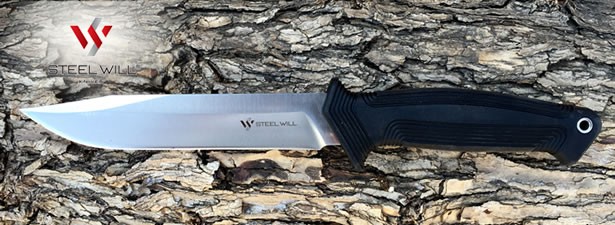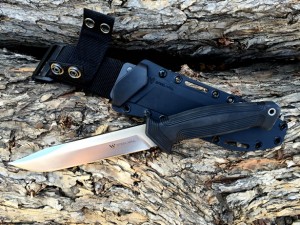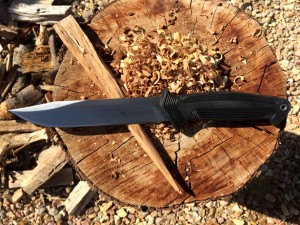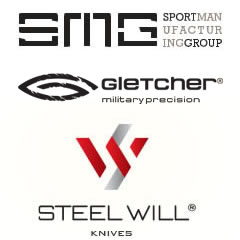Steel Will Argonaut 800 Reviewed

Marketing from Steel Will
The “Argonaut” is one of the most versatile outdoor knives in the Steel Will Outdoor Series and is designed for demanding work. The knife’s dimensions make it versatile and suitable for just about anything from work in the kitchen to chopping wood to skinning an animal. The “Argonaut” knife is designed with careful attention to detail. A comfortable TPR handles with deep grooves allows the Argonaut to be used with wet or slippery hands. Additional safety comes from the two-way guard which protects the hand under heavy duty work. The tang extends through the handle, forming a multi-purpose pommel/glass-breaker. The pommel is rounded and does not interfere with the handling of the knife. To further strengthen the integrity of this knife, the tang is devoid of sharp corners or edges which typically create stress points in the steel. Comes with a secure nylon sheath that allows carry in multiple configurations.
Manufacturer: Steel Will, steelwillknives.com
Model: Argonaut 800
Overall Length: 12.08 inch (30.68 cm)
Blade Finish: Satin
Blade Material: AUS-8
Blade-HRC: 56-58
Blade Length: 6.3 inch (16.0 cm)
Blade Thickness: 0.189 inch (4.80 mm)
Handle Material: Thermoplastic Rubber (TPR) Handle
Handle Length: 5.78 inch (14.68 cm)
Weight: 9.59 oz
Accessories: Nylon Belt Sheath
Warranty: Limited Lifetime Warranty against any manufacturing or material defects
Origin: Made in Taiwan
MSRP: $99.00
The Review
New to the knife scene in 2015, Steel Will has amassed an attractive collection of fixed and folding -blades and neck knives. One of their newest fixed-blade knives, the Argonaut 800 is due to be released as part of their Outdoor Series in a few short weeks. I recently had the opportunity to have an up-close and personal look at the Argonaut 800 prior to its release and put it through its paces.

Initial Thoughts
Well I have to admit… I always get excited when a new box arrives. It doesn’t even matter what it is. Just the thought of opening a box that has been dropped at my door has me feeling a little like Old Man Parker in A Christmas Story as he is opening the crate. After opening the shipping container, removing the packing material and pulling the box out, I was actually quite impressed with the packaging. “Fragilè” immediately came to mind.
The inner box slides out from the side of the outer box revealing the Argonaut 800 itself. The blade itself is covered with a thin cardboard sleeve and fixed to a cardboard platform inside of the box with two hook and loop straps during shipping. Hiding just below the cardboard platform is a durable reinforced nylon belt sheath.
The Argonaut 800 is made from a rugged AUS-8 stainless steel with a beautiful scratch-resistant brushed satin finish. It features a long, full-tang, clip-point blade pattern with an aggressive swedge ground deeply into a flat spine to further enhance the tip design. It also has a factory-sharpened edge with a high-flat saber grind with a micro-bevel.
The thermoplastic rubber (TPR) handle is just short of 6″ with an attractive rake design pattern for a slip-resistant grip that is comfortable to wield. The tang protrudes beyond the end of the handle forming a glass-breaker pommel that has been rounded to prevent it from interfering with the grip of the wielder.
 The nylon belt sheath provides many attachment options and can easily be configured for right or left -handed operation. The knife is held securely in place with a dual-button strap.
The nylon belt sheath provides many attachment options and can easily be configured for right or left -handed operation. The knife is held securely in place with a dual-button strap.
Steel Will’s limited lifetime warranty provided is pretty standard and inline with most in the industry.
Features
Now lets focus on the Argonaut 800’s features in more detail…
The Blade
The Argonaut 800 is made from a single piece of AUS-8 stainless steel, heat-treated to a hardness ranging between 56-58 HRC for superior strength, rigidity and edge retention. It is an impressive 12 inches long, 1-1/8 inches at its widest point and 3/16 of an inch thick. To further enhance the integrity of the tang, there are no sharp corners or tight radiuses which tend to create weak points susceptible to stress.
Stainless steel is a popular steel alloy for knife blades for its unparalleled rust and corrosion resistant properties that is relatively easy to maintain. AUS-8 in particular is an extremely durable Japanese-made high carbon, low chromium stainless steel alloy capable of holding a razor-sharp edge. It is typically heat-treated to a hardness somewhere between 58-59 HRC, a good compromise between strength, rigidity and resistance to wear, comparable to other stainless steel alloys like 440C, CM-154, and D2.
The clip-point profile has the appearance of the forward third of the blade being “clipped” off with a straight or concave shape. This offers a fast, deep puncture when stabbing and a rapid withdrawal upon retrieval due to the reduced drag of the blade’s point.
The shape of the Argonaut 800 is loosely based on a traditional clip-point blade pattern, with an aggressive swedge ground deeply into the spine near the end of the blade which enhances the tip and blade profile, reminiscent of the popular Bowie knife. A swedge, or false edge is an aggressive tapering of the spine from the tip to just beyond the clipped point which may be located above, below, or in line with the central axis of the blade. This can be sharpened to form a second cutting edge, further increasing its piercing capability.
The Argonaut 800 features a factory-sharpened edge with a high-flat saber grind with a micro-bevel. This edge is typically easy to maintain on a flat stone and in the field.
The spine of the blade has a sharp 90 degree edge, perfect for striking against a ferro rod and providing an ample shower of sparks without fear of wearing down the aggressive edge or damaging its attractive brushed satin finish. Brushed satin finishes are not only attractive, they tend to hide minor wear and scratches to keep it looking nice longer.
It is important to point out that AUS-8 is only rust resistant and not entirely rust proof, therefore this alloy is still susceptible to various forms of corrosion without proper care and maintenance. If the blade becomes wet, simply dry it thoroughly and lightly coat it with a protective oil like Break-Free CLP before you pack it away. If you do, it will likely last you a lifetime.
The Handle
The handle of the Argonaut 800 is made from a lightweight, durable synthetic thermoplastic rubber (TPR) just a hair over 5.75″ long. It has an attractive raked deep groove pattern that provide an enhanced slip-resistant grip that is very comfortable to wield, wet or dry, with or without gloves. The two-side hand guard is a moulded part of the handle for extra protection from the blade.
There is a hollow-riveted pin going all the way through the tang to secure the handle in place and provide a lanyard hole for quick and easy knife retention. The tang protrudes beyond the end of the handle forming a smooth pommel that has been rounded for a multitude of of uses including breaking glass and finely crushing various materials.
The Sheath
The Argonaut 800 comes with a durable nylon sheath made from a rigid fiberglass-reinforced thermoplastic with 13 riveted grommet holes for extra strength and four 1″ slots providing a multitude lashing options. The knife is held securely in place with a fixed dual-button strap. The beltloop system is designed to provide many attachment options and can easily be configured for right or left -handed operation.
Functional Testing
Now lets see what the Argonaut 800 can do… In order to provide a some sort of apples-to-apples comparison between blades, I will be performing five durability tests; Batoning, Chopping, Feather Stick, Tip Strength and Edge Retention. In a survival situation, all resources are fair game. However, since I am not in a life-or-death situation, I’ll stick to some dead wood that I have lying around for these tests.
Batoning
Per Wikipedia: Batoning is the technique of cutting or splitting wood by using a baton-sized stick or mallet to repeatedly strike the spine of a sturdy knife, chisel or blade in order to drive it through wood. The batoning method can be used to make kindling or desired forms such as boards, slats or notches. The practice is most useful for obtaining dry wood from the inside of logs for the purpose of fire making.
For this test, I tried to split a couple of 3″ logs a little less than 12″ in length. I used the baton about 2″ in diameter to strike the spine of the Argonaut 800 as I worked my way through each log, first halves, then quarters, and so on until I had neat little pile of perfectly sized kindling.
While the spine of the Argonaut 800 is a stout 3/16″ thick and perfect for batoning, the aggressively tapered swedge near the end of the spine does not lend itself well to being struck with the baton. I must have broken my baton at least a dozen times before I had to grab a second one to finish. However, the high-flat grind and super-sharp blade were enough of an advantage to eventually make through the logs in spite of the small chunks of baton that I had lost.
Chopping
To test the Argonaut 800’s ability as a chopper, I thought I would try to buck a small 4″ log after delimbing it, much like you would if you were building a shelter or creating a stockpile of firewood for a small campfire.
 The Argonaut 800 has a long-slender blade profile that is very lightweight. But typically not an ideal quality for a chopper so I felt that more than one log would be a little too ambitious for myself. However, the handle is extremely comfortable to hold toward the end of the handle with a three-finger grip allowing the small finger to ride against the butt of the handle providing some additional leverage, which translated into a little extra power in each swing. I was able to chop through the smaller limbs and foliage without any difficulty whatsoever, often with only a single swing. This made delimbing the log quick and easy.
The Argonaut 800 has a long-slender blade profile that is very lightweight. But typically not an ideal quality for a chopper so I felt that more than one log would be a little too ambitious for myself. However, the handle is extremely comfortable to hold toward the end of the handle with a three-finger grip allowing the small finger to ride against the butt of the handle providing some additional leverage, which translated into a little extra power in each swing. I was able to chop through the smaller limbs and foliage without any difficulty whatsoever, often with only a single swing. This made delimbing the log quick and easy.
To buck the log after delimbing it, you simply strike the log at a 45° angle from two perpendicular directions along the cut-line, effectively making a “V” in the material used to be, otherwise known as the kerf. The kerf should equal the diameter of the limb or trunk, and when cutting from both sides, the kerf would essentially be half diameter.
After a few swings at the log, I noticed it biting quite deep into the material, though not quite as well as some recurves and heavier choppers tend to do. But for how slender and lightweight this blade is, it definitely held its own. It did take quite a few swings to finally make it through the material. However, I was not overly spent from repeatedly swinging this light blade. I think it would surely be better to have a hand axe or hatchet on hand for the heavier stuff. But if it’s all you’ve got, just work with some smaller material and you’ll be fine.
Feathering A Stick
Per Wikipedia: A feather stick (sometimes referred to as a fuzz stick) is a length of wood which is shaved to produce a head of thin curls protruding from the wood. It is used for damp wood to start a fire (or campfire) when dry tinder is hard to find.
For this test I chose to feather one of the pieces of kindling that I had split earlier while batoning. It was about 1″ square and around 12″ in length. I began by taking long strokes along the corners of the stick and round it, starting about 6″ up from the bottom.
 As I worked my way around careful not to dig in, finely shaved curls otherwise known as “feathers” began to collect on my work surface. Full-flat, high-flat and scandi ground blades tend to excel at feathering sticks and the blade of the Argonaut 800 is no different. After a few short minutes, I had a pile of shavings easily large enough to start a fire with a ferro rod. Out of the box the Argonaut 800 is certainly sharp enough to process the shavings that I needed and the blade grind only simplified the experience.
As I worked my way around careful not to dig in, finely shaved curls otherwise known as “feathers” began to collect on my work surface. Full-flat, high-flat and scandi ground blades tend to excel at feathering sticks and the blade of the Argonaut 800 is no different. After a few short minutes, I had a pile of shavings easily large enough to start a fire with a ferro rod. Out of the box the Argonaut 800 is certainly sharp enough to process the shavings that I needed and the blade grind only simplified the experience.
Tip Strength
Testing the its ability to stab or pierce without bending or breaking the narrow tip, I drove the blade into the end of a 12″ stump with a baton about an 1-1/2″ deep. Then I loosened the blade using a side-to-side motion until it became loose enough to pull out. I repeated this action a few more times without any sign of bending, breaking, or chipping.
The final test was to bore a hole into the side of a 3″ log by twisting the Argonaut 800 back and forth. After about 5 minutes of this, I had a hole approximately 1″ in diameter and about 1-1/2″ deep. The tip is aggressive and performed exceptionally well at this task with no sign of tip damage whatsoever.
Edge Retention
After all other functional testing was said and done, I was able to slice cleanly through a single sheet of copy paper with ease. Performing these simple tests left no sign of cracks, chips or imperfections of any kind, and with a quick wipe with a lightly oiled rag all evidence of use throughout the day wiped away. The Argonaut 800 held its edge while remaining clean and sharp throughout all functional tests, just as you would expect from a good outdoor blade.
Final Thoughts
The Argonaut 800 is made from rugged lightweight materials easily capable of handling most any survival or tactical task with ease. Its full-tang AUS-8 stainless steel blade and high-flat grind provides exceptional durability, edge-retention and scratch-resistance, finished with a brilliant brushed satin to further enhance its look while obscuring normal wear and tear. The attractive TPR handle provides a high-level of impact and slip -resistance resulting in blade that is ergonomic and very comfortable to wield for extended periods of time.
At a little over 12 inches, I found the Argonaut 800 to be a formidable survival/tactical blade perfectly capable of performing bushcraft tasks and more. Its quality is very high and with a little care and maintenance from time to time, this blade will likely last you a lifetime. Certainly worthy of two thumbs up!
You can find this and other Steel Will knives here: http://amzn.to/2bv7Joq
![]()
About SMG Inc and Steel Will
 SMG Inc. is an American company established in 2008. They specialize in the production of pneumatic guns under the brand “Gletcher”, as well as tactical and outdoor knives under the brand “Steel Will Knives”. SMG prides themselves on making products with the highest level of performance, quality, and craftsmanship. For more information on their entire line of products, please visit www.smgoutdoor.com.
SMG Inc. is an American company established in 2008. They specialize in the production of pneumatic guns under the brand “Gletcher”, as well as tactical and outdoor knives under the brand “Steel Will Knives”. SMG prides themselves on making products with the highest level of performance, quality, and craftsmanship. For more information on their entire line of products, please visit www.smgoutdoor.com.
OUR BRANDS
Gletcher is a brand of pneumatic guns and accessories, established by SMG Inc. Our slogan, “Military Precision”, emphasizes the high level of implementation of our air guns both in function and design. It also reflects the passion it evokes in our customers. In creating the Gletcher brand and products, we tried to fill a void for customers who appreciate firearms but due to cultural and regulatory issues were unable to own these types of items.
We are proud to debut our new brand of knives called “Steel Will”. In creating these beautiful knives, we’ve combined the finest steel with extremely practical and innovative designs. The result is a line of knives that are meant to be used and adored by their owners. Steel Will Knives are produced according to the highest standards of quality, using the most modern methods of production. We have set a high bar for our products and will continue to do so in the future. We are confident that the quality of our knives will meet the requirements of the most discerning buyers.
--